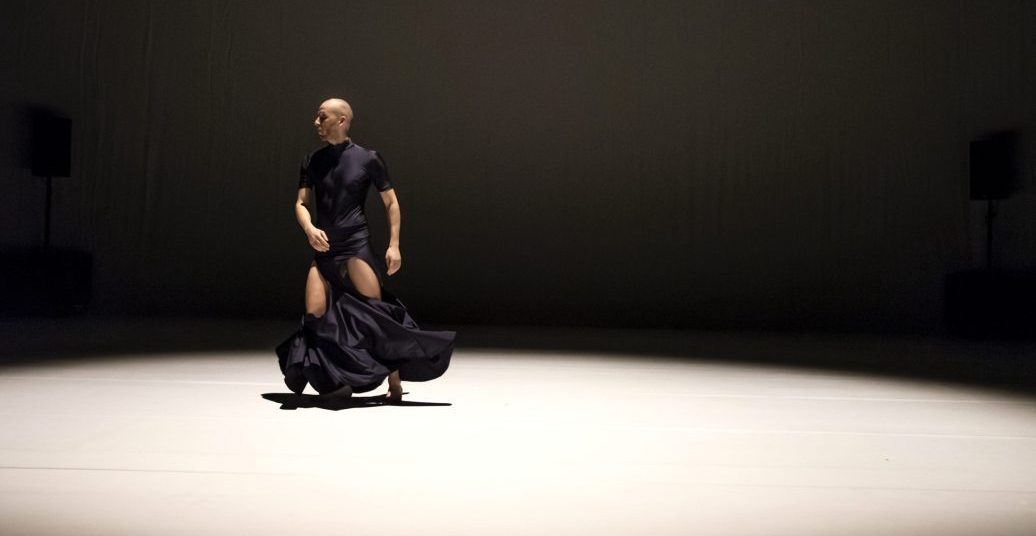In “Elisabeth Gets Her Way” (shown on 6 and 7 October at Fabrik Potsdam within the framework of Potsdamer Tanztage 2021) Belgian dancer and choreographer Jan Martens pays a vibrant tribute to Elisabeth Chojnacka, who is widely recognised as one of the most prominent harpsichordists of the 20th century. Devised as a string of seven solos masterfully executed by Martens himself, the show ostensibly explores the rhythmic universe of harpsichord music and the vastness of Chojnacka’s repertoire. But Martens also wants the audience to get to know Elisabeth Chojnacka more intimately, and amplifies the work with archive materials to draw a poignant portrait of a strong-willed and influential musician. And the show, initially envisaged as a solo tribute, becomes a dazzling dialogue between two uncompromising performers.
Elisabeth …
I can easily remember a dozen dance works, in which choreographers paid homage to their peers, prominent dancers, or composers. Instrumentalists appear only rarely in the spotlight of choreographic research. Jan Martens has brilliantly remedied this omission, turning to the figure of Elisabeth Chojnacka, a Polish harpsichordist who largely contributed to the revival of interest in harpsichord music in the 20th century.
“Elisabeth Gets Her Way” follows a crystal-clear structure. Seven dance solos are each set to harpsichord pieces performed by Chojnacka and are separated by short audio and video interludes. These archive materials feature Chojnacka’s collaborators, composers, and choreographers, such as Iannis Xenakis and Lucinda Childs, who describe an exuberant and exceptionally hard-working musician, whose prowess and talent induced many composers to write harpsichord pieces especially for her.
I am already melting as the first notes of Manuel de Falla’s “Concerto for Harpsichord” play. Harpsichord music has always affected me on a visceral level. Its clipped yet soothing tones produce an eerie tingling sensation in my limbs, put my mind at ease, and create a pleasing vibration in my eardrums. I was convinced before seeing the show that “Elisabeth Get Her Way” would at least find its way to my ears, but how would one convincingly translate complex rattling harpsichord sounds into movement?
… and Jan …
Martens builds his dance score to the same pattern throughout the show: brief and cursory forearm movements, kicks and shoulder dips correspond to the short notes of the bass line, while sweeping and ample gestures and stretches rhyme with dramatic accents and pauses. Attentive to each accord and percussive beat, Martens effortlessly embeds multiple references to minuet, modern dance, and apparently even to Anne Teresa de Keersmaeker’s “Violin Phase”.
Assisted by Cédric Charlier’s clever costume design, Martens then also adds multiple layers of contrast to the music score, as if he is playing with the pieces played by Chojnacka. To the notes of pensive and melodic “Uppon La Mi Ré” written by an anonymous 16th century composer, Martens, clad in a bright jumpsuit and white sneakers, performs an energetic club dance sequence with brief sidesteps and fluid shoulder and neck movements. The roaring rhythm of György Lygeti’s “Continuum” sees the dancer standing in profile and slowly moving his arm clockwise, as if it were a hand of a clock. Concentrated and retained in most solos, Martens suddenly explodes with raw emotion in the second tableau set to Stephen Montague’s intense and minimalist “Phrygian Tucket”. He quickly advances to the scarcely lit centre of the stage and swiftly engages in a fierce and dramatic ritual. His arms cut the air and his whole body vibrates in response to each cluster of repetitive pluck sounds. Not a single note is left without its choreographic counterpart. I gasp in awe and hold my breath until the end of the show.
… get their way.
Tribute is usually understood as a formal act of respect or admiration (for someone). It would be an understatement, however, to confine interpretations of “Elisabeth Gets Her Way” to those of conventional homage. Rather, Martens deftly creates a space in which Chojnacka’s thrilling musical performance enters into dialogue with his generous choreographic score. He plays and twists his body in a fashion that reflects the way Chojnacka plays the harpsichord, and is as radical in his game of contrasts and sudden shifts of rhythm as she was in her choice of repertoire, which ranged from the 16th to the 20th century. It is precisely Martens’ unorthodox approach to ‘dancing the music’ that enables him to create the emotional tension, that carries the show forward.
In one of the interludes, just before Michael Nyman’s stunning “Tango for Tim”, Chojnacka’s voice is played out across the stage delivering her magical formula that Martens could easily make his own: “I perform with my head, my hands, my body, and it is glorious!” And it is just as glorious to watch and hear Martens and Chojnacka fuse their art in a riveting celebration of radical emotional force.
Choreography and Dance: Jan Martens — Sound Design for the Documentary: Yanna Soentjens — Lighting Design: Elke Verachtert — Costume Design: Cédric Charlier — Technician: Michel Spang and Elke Verachtert — Outside Eye: Marc Vanrunxt, Anne-Lise Brevers, and Rudi Meulemans — Production: GRIP
“Elisabeth gets her way” was presented on 6 & 7 October 2021 at fabrik Potsdam in the frame of Potsdamer Tanztage 2021. For touring dates and full music and video credits visit the website of GRIP.




